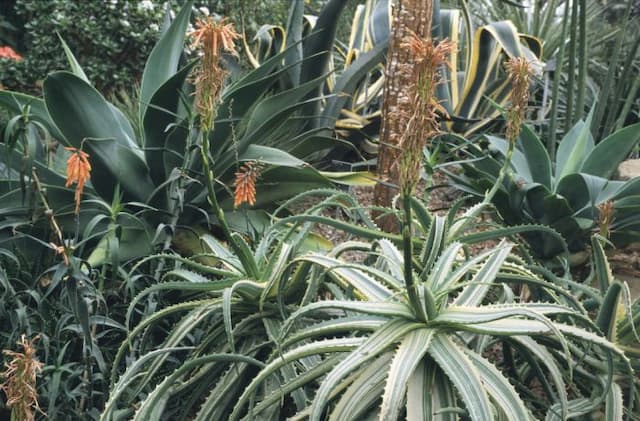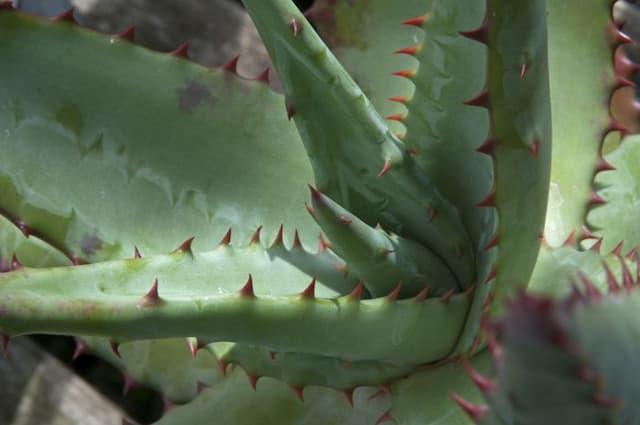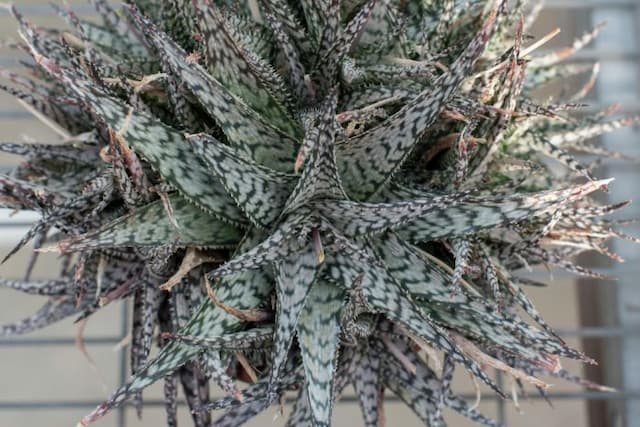Red Hot Poker Kniphofia 'Dingaan'

ABOUT
Kniphofia 'Dingaan', commonly known as the Red Hot Poker, has a striking appearance characterized by its bold, vertical lines and vibrant coloration. The plant features a clump-forming habit with long, strap-like, arching leaves that are rich green in color and have a somewhat leathery texture. From this foliage emerge tall, sturdy stalks that hold aloft the distinctive torch-like flower spikes. The blooms of Dingaan Red Hot Poker are truly the standout feature, gradually changing color as they mature. They display a fiery array of shades, typically starting with a bright red at the top, transitioning through orange, and sometimes fading into a soft yellow toward the bottom. The buds are densely packed around each spike, opening sequentially from the bottom to the top, which prolongs the flowering display. Visually, the contrast between the dark green leaves and the vibrant, warm-colored flower spikes makes for an eye-catching display in the garden. The Red Hot Poker is a favorite among gardeners looking to add a touch of drama and a tropical flair to their borders or flower beds. Its unique blooms also attract pollinators such as hummingbirds and bees, adding movement and life to its surroundings. The plant radiates a bold, structural quality that can serve as both a focal point in a garden design or as part of a larger, textured planting scheme.
About this plant
 Names
NamesFamily
Asphodelaceae
Synonyms
Red Hot Poker, Torch Lily, Tritoma
Common names
Kniphofia 'Dingaan'.
 Toxicity
ToxicityTo humans
The Kniphofia 'Dingaan', commonly known as Red Hot Poker, does not have widespread reports of toxicity to humans. While it does not appear on most toxic plant lists, it is always prudent to avoid ingestion of any garden plant not designated as edible, as they could potentially cause gastrointestinal upset or allergic reactions in some individuals. However, there are no specific documented symptoms of poisoning from ingesting the Red Hot Poker for humans.
To pets
The Red Hot Poker is not commonly listed as a toxic plant for pets. While it is typically not associated with severe poisoning, it is not considered a pet-friendly plant due to potential mild gastrointestinal upset if ingested by animals. Animals consuming Red Hot Poker may exhibit mild vomiting or diarrhea, but significant toxicity is not widely reported. It is always best to discourage pets from chewing on any non-edible plants to prevent any possible adverse effects.
 Characteristics
CharacteristicsLife cycle
Perennials
Foliage type
Evergreen
Color of leaves
Green
Flower color
Mixed
Height
3-4 feet (0.9-1.2 meters)
Spread
2 feet (0.6 meters)
Plant type
Herb
Hardiness zones
5-9
Native area
Africa
Benefits
 General Benefits
General Benefits- Attracts Pollinators: Kniphofia 'Dingaan', commonly known as Red Hot Poker, is known to attract bees, butterflies, and hummingbirds, enhancing pollination in the garden.
- Low Maintenance: This plant is drought-tolerant once established, requiring minimal watering and upkeep, making it ideal for gardeners seeking low-maintenance options.
- Year-Round Interest: With evergreen foliage and vibrant flower spikes that bloom from late spring to early summer, the Red Hot Poker provides visual interest throughout multiple seasons.
- Landscaping Versatility: The unique flowering spikes and grass-like foliage add architectural interest, making it a versatile choice for various landscaping themes and garden designs.
- Drought Tolerance: Suited to dry climates and conditions, the Red Hot Poker is an excellent choice for water-wise gardens and xeriscaping.
 Medical Properties
Medical PropertiesThis plant is not used for medical purposes.
 Air-purifying Qualities
Air-purifying QualitiesThis plant is not specifically known for air purifying qualities.
 Other Uses
Other Uses- Photography Subject: The vibrant colors and unique shape of the Red Hot Poker can be a striking subject for nature and macro photography.
- Horticultural Art: Artists may use the distinct form of Red Hot Poker flowers in botanical illustrations or garden-themed art pieces.
- Edible Landscaping: Though not commonly eaten, the blooms can potentially be used for edible landscaping to add color and interest to a culinary garden.
- Dried Flower Arrangements: Red Hot Poker flowers can be dried and used in long-lasting floral displays and crafts.
- Natural Dye: The flowers of Red Hot Poker may be used as a source of natural dye for fabrics or yarns in crafting.
- Tattoo Inspiration: The Red Hot Poker's striking look can serve as inspiration for floral-themed tattoos.
- Garden Theme Design: Plant enthusiasts can use Red Hot Pokers to create a fire-themed garden due to their flame-like flower spikes.
- Feng Shui: Some might consider the plant's upward growth and bright coloration indicative of positive energy, integrating it into Feng Shui practices.
- Eco-Friendly Garden Practices: The dense foliage can provide a habitat for beneficial garden insects and an ecological balance in garden design.
- Teaching Tool: Kniphofia 'Dingaan' can be utilized in educational settings to teach about plant morphology, pollination, and biodiversity.
Interesting Facts
 Feng Shui
Feng ShuiThe Red Hot Poker is not used in Feng Shui practice.
 Zodiac Sign Compitability
Zodiac Sign CompitabilityThe Red Hot Poker is not used in astrology practice.
 Plant Symbolism
Plant Symbolism- Passion and Exoticism: With its striking, fiery blooms, Kniphofia, commonly known as 'Red Hot Poker' or 'Torch Lily,' is often associated with feelings of passion and a hint of exotic flair, reflecting its vibrant, showy flower spikes which are reminiscent of a torch.
- Standout Presence: The Red Hot Poker symbolizes an individual or feature that demands attention. Its prominent and bold presence in gardens can signify confidence and the desire to be noticed.
- Vitality and Energy: The bright, energetic colors of the Torch Lily are emblematic of vitality and life force. This symbolism underscores the plant's ability to inject vibrancy into any setting or to embody vivacious personalities.
- Attraction and Vibrance: Just as the Red Hot Poker is a magnet for hummingbirds and butterflies, it symbolizes attraction and the ability to draw others in with one's charisma and colorful character.
 Water
WaterRed hot poker plants, including the Kniphofia 'Dingaan', prefer consistent moisture but require well-draining soil to prevent root rot. During the active growing season, typically spring through fall, water the plant thoroughly to ensure the soil is moist to a depth of about an inch, which might equate to approximately 1 gallon per plant, depending on the size and soil composition. Watering should be done once a week, but frequency may need to increase during particularly hot or dry periods. During the winter, reduce watering, allowing the soil to dry out slightly between waterings. Always check the soil moisture before watering to prevent overwatering.
 Light
LightThe Red hot poker thrives in full sun conditions, requiring at least six hours of direct sunlight each day. A spot in your garden that receives long hours of uninterrupted sunlight is ideal for promoting strong growth and vibrant flower spikes. Avoid locations that are too shaded, as this can diminish blooming and weaken the plant.
 Temperature
TemperatureThe Red hot poker plant is adapted to a wide range of temperatures, able to withstand minimum winter temperatures of about 10°F. However, it flourishes in warmer conditions, with the ideal temperature range for active growth between 50°F and 75°F. Extreme heat above 90°F may require additional watering to keep the plant hydrated.
 Pruning
PruningPruning the Red hot poker involves removing spent flower spikes to encourage new blooms and maintain plant vigor. Additionally, trim back any damaged or yellowing foliage to keep the plant tidy and to prevent potential disease spread. The best time for pruning is after flowering has ceased or in early spring before new growth begins.
 Cleaning
CleaningAs needed
 Soil
SoilRed Hot Poker thrives in well-draining, fertile soil. Ideal soil mix includes peat, perlite, and compost with a pH of 5.6 to 7.5, ensuring proper drainage and aeration.
 Repotting
RepottingRed Hot Poker, as a perennial, does not require frequent repotting. Repot only if it outgrows its container, typically every 3-5 years to refresh the soil.
 Humidity & Misting
Humidity & MistingRed Hot Poker prefers moderate humidity and tolerates a wide range of conditions; it does not require any special humidity adjustments for optimal growth.
 Suitable locations
Suitable locationsIndoor
Place Red Hot Poker in bright light.
Outdoor
Full sun, sheltered from strong winds.
Hardiness zone
5-9 USDA
 Life cycle
Life cycleThe Kniphofia 'Dingaan', commonly known as Red Hot Poker, begins its life cycle when seeds are sown in well-draining soil during spring or by dividing mature plants. After germination, seedlings emerge and continue to grow into young plants, developing a rosette of narrow, strap-like leaves. As the plants mature, they form evergreen clumps that can reach up to 3-4 feet tall. In the second or third year, flower spikes start to shoot up from the base, displaying tubular flowers that typically bloom in shades of orange, red or yellow from late spring to early summer. After pollination by birds and insects, seeds form and can be collected for propagation or left to self-sow in favorable conditions. The plant eventually enters a period of dormancy in the winter, especially in cooler climates, before resuming growth in the spring.
 Propogation
PropogationPropogation time
Spring to Summer
The most popular method of propagation for the Kniphofia 'Dingaan', commonly known as Red Hot Poker, is by division. This process is ideally carried out in late spring after the risk of frost has passed or in early fall. To propagate by division, carefully dig up the entire plant, ensuring to lift as much of the root system as possible. Using a sharp spade or knife, divide the clump into smaller sections, each containing several shoots and a portion of the root system. Replant the divisions immediately, spacing them about 18 inches (approximately 45.7 centimeters) apart, and water them thoroughly to help establish the new plants. This method is efficient and helps to rejuvenate older clumps that may have become woody in the center while providing an easy way to multiply your Red Hot Pokers.









